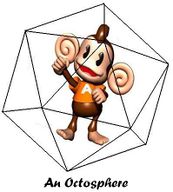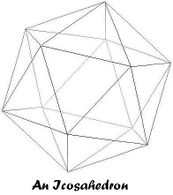Octosphere model of trust
“I pity the foo' who still uses a circular model of trust.”
– Mr T on The Octosphere model of trust
“Children! I have seen the future. There was a monkey in it.”
– Oscar Wilde on Octospheres
“You think I left it there?”
– Charles Darwin on The monkey
The Octosphere model of trust was first proposed by Dr Syllabear (Department of bizzarogeometry, faculty of Architecture, Calcutta Institute of Technology) sometime in 2005. It was first published in Particulate Matter Monthly (Al Jazeera press) in January 2006, however it received little attention in the growing fields of bizzarophysics and uncomathematics.
The original article is best described as lengthy, at 223 pages, of which a brief summary is offered below.
Problems with other models of trust[edit | edit source]
The circular model of trust is commonly employed by many people. It is often ambiguous, with no consensus even among users as to how the geometry of the circle gives an estimation trust.
Two possible models of comparative trust using the geometry of the circle are described here.
Model A locates the possessor of the circle of trust in the centre of the circle. This model is the more restrictive of the two. Every member in the circle of trust is equidistant from the individual. This reduces the question of trust to a simple binary proposition of “Do I trust this person?”, which is clearly inadequate. Trust is a more complex concept than to reduce it to something so simple.
In Model B, the possessor occupies a space within the circle of trust. This overcomes the problem of Model A, as levels of trust based on distance can be resolved. However this model is not without it’s own faults.
People who represent their trust hierarchy with the circle employ phrases such as “break a link in the circle of trust”. This raises the question of how the circle of trust changes when the relationship between two members changes. Ie. Is the trust between Red and Purple altered if the trust between Red and Green is altered?
This model also disregards the old adage “keep your friends close, and your enemies closer”. With this model persons in the circle can be infinitesimally close to the circle’s owner. Any respectable model of represent trust would have a way to isolate the truster from the recipients.
When adamant ‘circle advocate’ Jack Byrnes was questioned as to whether he subscribed to model A or B he bumbled “err... yes and no, not at once, and only sometimes”.
Instead of justifying or rectifying these ambiguous statements, Dr Syllabear proposed an entirely new model of trust, based on an uncosolid, the octosphere.
The equivalent of the octosphere in geometry would be the icosahedron.
The only difference between the two is that octospheres have been known to contain monkeys, whereas icosahedrons have never shown this property
Using the Octosphere of trust[edit | edit source]
The octosphere has many edges. On each of these edges individuals are placed. Their distance from the centre of the octosphere is a function of trust.
Consider one edge (black) and the angles from it to the centre of the octosphere (red). The distance from the centre to the edge is the radius (r). r is the minimum measure of trust, herein noted as t. The maximum value for trust is labeled T.
Therefore using this model, numerical representations of trust vary between t and T.
From the diagram we can see that
Therefore
And
So trust values range between
Which can be re-written as
as
Now we will call the trust-co-efficient .
So the range of values is now
or
where
The above equation lets you place person into your octosphere of trust.
Some examples using the above formula[edit | edit source]
If you trust someone half as you trust your most trusted person, then the trust variable would be , or
This would equate to
So along length , you would plot the person 0.5 of the way along, in either direction (due to the beautiful symmetry of the octosphere)
Another example. If you trust someone say 20% of how much you trust your most trusted individual, you would plot them
of the way along length of .
Notice in these example . For different values of r, the length will change. For simplicity it is best to have the length as 1, as it makes these calculations easier.
If the distance , then the calculation of the trust ordinate can be simplified to
Advantages of the Octosphere model of trust[edit | edit source]
1) It dissolves the ambiguity of circular models of trust
2) There is a minimum distance (t) separating the truster and trust-accepters.
3) It has all the benefits of being three dimensional
4) It has 20 edges, which can accommodate many individuals each.
5) It has 12 vertices, which can accommodate individuals of maximum trust.
6) It has monkeys in it
7) The owner of the octosphere doesn’t occupy it in a part that trust-recipients do (ala circle model B)
8) It makes This guy smile






















